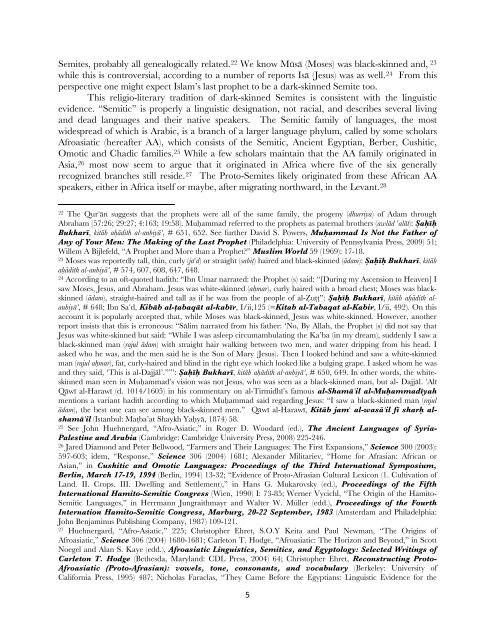“Anyone who says that the Prophet is black should be killed”: The ...
“Anyone who says that the Prophet is black should be killed”: The ...
“Anyone who says that the Prophet is black should be killed”: The ...
Create successful ePaper yourself
Turn your PDF publications into a flip-book with our unique Google optimized e-Paper software.
Semites, probably all genealogically related. 22 We know Mås§ (Moses) was <strong>black</strong>-skinned and, 23<br />
while th<strong>is</strong> <strong>is</strong> controversial, according to a num<strong>be</strong>r of reports Is§ (Jesus) was as well. 24 From th<strong>is</strong><br />
perspective one might expect Islam’s last prophet to <strong>be</strong> a dark-skinned Semite too.<br />
Th<strong>is</strong> religio-literary tradition of dark-skinned Semites <strong>is</strong> cons<strong>is</strong>tent with <strong>the</strong> lingu<strong>is</strong>tic<br />
evidence. “Semitic” <strong>is</strong> properly a lingu<strong>is</strong>tic designation, not racial, and descri<strong>be</strong>s several living<br />
and dead languages and <strong>the</strong>ir native speakers. <strong>The</strong> Semitic family of languages, <strong>the</strong> most<br />
widespread of which <strong>is</strong> Arabic, <strong>is</strong> a branch of a larger language phylum, called by some scholars<br />
Afroasiatic (hereafter AA), which cons<strong>is</strong>ts of <strong>the</strong> Semitic, Ancient Egyptian, Ber<strong>be</strong>r, Cushitic,<br />
Omotic and Chadic families. 25 While a few scholars maintain <strong>that</strong> <strong>the</strong> AA family originated in<br />
Asia, 26 most now seem to argue <strong>that</strong> it originated in Africa where five of <strong>the</strong> six generally<br />
recognized branches still reside. 27 <strong>The</strong> Proto-Semites likely originated from <strong>the</strong>se African AA<br />
speakers, ei<strong>the</strong>r in Africa itself or may<strong>be</strong>, after migrating northward, in <strong>the</strong> Levant. 28<br />
22 <strong>The</strong> Qur"§n suggests <strong>that</strong> <strong>the</strong> prophets were all of <strong>the</strong> same family, <strong>the</strong> progeny (dhurriya) of Adam through<br />
Abraham (57:26; 29:27; 4:163; 19:58). MuÈammad referred to <strong>the</strong> prophets as paternal bro<strong>the</strong>rs (awl§d #al§t): ‘aÈÊÈ<br />
BukharÊ, kit§b aȧdith al-anbiy§", # 651, 652. See fur<strong>the</strong>r David S. Powers, MuÈammad Is Not <strong>the</strong> Fa<strong>the</strong>r of<br />
Any of Your Men: <strong>The</strong> Making of <strong>the</strong> Last <strong>Prophet</strong> (Philadelphia: University of Pennsylvania Press, 2009) 51;<br />
Willem A Bijlefeld, “A <strong>Prophet</strong> and More than a <strong>Prophet</strong>?” Muslim World 59 (1969): 17-18.<br />
23 Moses was reportedly tall, thin, curly (ja#d) or straight (sabiã) haired and <strong>black</strong>-skinned (§dam): ‘aÈÊÈ BukharÊ, kit§b<br />
aȧdith al-anbiy§", # 574, 607, 608, 647, 648.<br />
24 According to an oft-quoted hadith: “Ibn Umar narrated: <strong>the</strong> <strong>Prophet</strong> (s) said: “[During my Ascension to Heaven] I<br />
saw Moses, Jesus, and Abraham. Jesus was white-skinned (aÈmar), curly haired with a broad chest; Moses was <strong>black</strong>skinned<br />
(§dam), straight-haired and tall as if he was from <strong>the</strong> people of al-£uãã”: ‘aÈÊÈ BukharÊ, kit§b aȧdith alanbiy§",<br />
# 648; Ibn Sa#d, Kib§b al-ãabaq§t al-kabÊr, I/ii,125 (=Kitab al-Tabaqat al-Kabir, I/ii, 492). On th<strong>is</strong><br />
account it <strong>is</strong> popularly accepted <strong>that</strong>, while Moses was <strong>black</strong>-skinned, Jesus was white-skinned. However, ano<strong>the</strong>r<br />
report ins<strong>is</strong>ts <strong>that</strong> th<strong>is</strong> <strong>is</strong> erroneous: “S§lim narrated from h<strong>is</strong> fa<strong>the</strong>r: ‘No, By Allah, <strong>the</strong> <strong>Prophet</strong> (s) did not say <strong>that</strong><br />
Jesus was white-skinned but said: “While I was asleep circumambulating <strong>the</strong> Ka’ba (in my dream), suddenly I saw a<br />
<strong>black</strong>-skinned man (rajul §dam) with straight hair walking <strong>be</strong>tween two men, and water dripping from h<strong>is</strong> head. I<br />
asked <strong>who</strong> he was, and <strong>the</strong> men said he <strong>is</strong> <strong>the</strong> Son of Mary (Jesus). <strong>The</strong>n I looked <strong>be</strong>hind and saw a white-skinned<br />
man (rajul aÈmar), fat, curly-haired and blind in <strong>the</strong> right eye which looked like a bulging grape. I asked <strong>who</strong>m he was<br />
and <strong>the</strong>y said, ‘Th<strong>is</strong> <strong>is</strong> al-Dajj§l’.”’”: ‘aÈÊÈ BukharÊ, kit§b aȧdith al-anbiy§", # 650, 649. In o<strong>the</strong>r words, <strong>the</strong> whiteskinned<br />
man seen in MuÈammad’s v<strong>is</strong>ion was not Jesus, <strong>who</strong> was seen as a <strong>black</strong>-skinned man, but al- Dajj§l. #AlÊ<br />
Q§wÊ al-HarawÊ (d. 1014/1605) in h<strong>is</strong> commentary on al-TirmidhÊ’s famous al-Sham§"il al-MuÈammadÊyah<br />
mentions a variant hadith according to which MuÈammad said regarding Jesus: “I saw a <strong>black</strong>-skinned man (rajul<br />
§dam), <strong>the</strong> <strong>be</strong>st one can see among <strong>black</strong>-skinned men.” Q§wÊ al-HarawÊ, Kit§b jam# al-was§"il fÊ sharÈ alsham§"il<br />
(Istanbul: Maãba’at Shaykh YaÈy§, 1874) 58.<br />
25 See John Huehnergard, “Afro-Asiatic,” in Roger D. Woodard (ed.), <strong>The</strong> Ancient Languages of Syria-<br />
Palestine and Arabia (Cambridge: Cambridge University Press, 2008) 225-246.<br />
26 Jared Diamond and Peter Bellwood, “Farmers and <strong>The</strong>ir Languages: <strong>The</strong> First Expansions,” Science 300 (2003):<br />
597-603; idem, “Response,” Science 306 (2004) 1681; Alexander Militariev, “Home for Afrasian: African or<br />
Asian,” in Cushitic and Omotic Languages: Proceedings of <strong>the</strong> Third International Symposium,<br />
Berlin, March 17-19, 1994 (Berlin, 1994) 13-32; “Evidence of Proto-Afrasian Cultural Lexicon (1. Cultivation of<br />
Land. II. Crops. III. Dwelling and Settlement),” in Hans G. Mukarovsky (ed.), Proceedings of <strong>the</strong> Fifth<br />
International Hamito-Semitic Congress (Wien, 1990) I: 73-85; Werner Vycichl, “<strong>The</strong> Origin of <strong>the</strong> Hamito-<br />
Semitic Languages,” in Herrmann Jungraithmayr and Walter W. Müller (edd.), Proceedings of <strong>the</strong> Fourth<br />
Internation Hamito-Semitic Congress, Marburg, 20-22 Septem<strong>be</strong>r, 1983 (Amsterdam and Philadelphia:<br />
John Benjaminus Publ<strong>is</strong>hing Company, 1987) 109-121.<br />
27 Huehnergard, “Afro-Asiatic,” 225; Chr<strong>is</strong>topher Ehret, S.O.Y Keita and Paul Newman, “<strong>The</strong> Origins of<br />
Afroasiatic,” Science 306 (2004) 1680-1681; Carleton T. Hodge, “Afroasiatic: <strong>The</strong> Horizon and Beyond,” in Scott<br />
Noegel and Alan S. Kaye (edd.), Afroasiatic Lingu<strong>is</strong>tics, Semitics, and Egyptology: Selected Writings of<br />
Carleton T. Hodge (Be<strong>the</strong>sda, Maryland: CDL Press, 2004) 64; Chr<strong>is</strong>topher Ehret, Reconstructing Proto-<br />
Afroasiatic (Proto-Afrasian): vowels, tone, consonants, and vocabulary (Berkeley: University of<br />
California Press, 1995) 487; Nicholas Faraclas, “<strong>The</strong>y Came Before <strong>the</strong> Egyptians: Lingu<strong>is</strong>tic Evidence for <strong>the</strong><br />
5
















